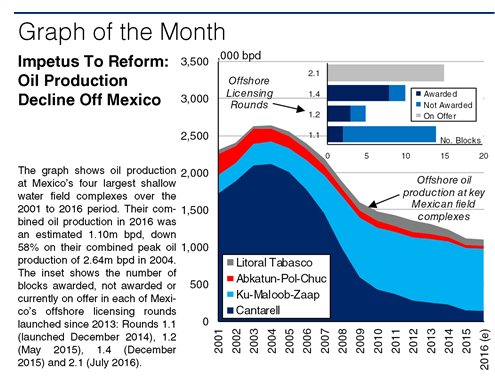Mexican Shallow Water E&P: On The Road Again?
To much fanfare and accompanied by voluminous industry coverage, Mexico recently concluded Round 1.4, the country’s first ever deepwater licensing round. However, Mexico’s shallow waters may yet have a future too: Bay of Campeche reserves remain considerable and indeed, the country’s third shallow water bid round is ongoing. It is therefore worth reviewing the current state of shallow water E&P in Mexico.
Veering Off Course
Mexican offshore oil is currently produced entirely from shallow water fields, as has always been the case. The key sources of Mexican offshore oil have been several large field complexes such as Cantarell and Ku-Maloob-Zaap. As these fields and others came online, the country’s offshore oil output grew with a robust CAGR of 6.6% from 1980 to 2004, reaching a peak of 2.83m bpd in 2004. As the graph implies, four complexes accounted for 93% of this production. Decline set in thereafter at ageing fields (production at Cantarell began at the Akal field in 1979). Pemex – the sole operator of Mexican offshore fields prior to 2014 – tried to halt production decline, but with little success, given budget and technical constraints. Thus by 2013, offshore oil production at the four key field complexes had fallen to 1.31m bpd, accounting for 69% of Mexico’s offshore oil production of 1.90m bpd.

Getting Back On Track
This situation prompted President Peña Nieto’s government to initiate energy sector reforms in 2013, opening up the country’s upstream sector to foreign companies for the first time since 1938. Pemex was granted 83% of Mexican 2P reserves in “Round Zero” in 2014. The first shallow water round, Round 1.1, followed in December 2014. Only two of 14 blocks were awarded though, reportedly due to unfavourable fiscal terms inhibiting bidding by oil companies. The authorities then improved terms before launching Round 1.2 (shallow water), Round 1.3 (onshore) and Round 1.4 in 2015. Round 1.2 was better received than 1.1: as per the inset, 60% of blocks were awarded (75% of the km2 area on offer). One of the round’s victors, Eni, has already been granted permission to drill four appraisal wells on Block 1.
Turning Things Around?
In light of these positives, there are high hopes for Round 2.1, a shallow water round launched in July 2016. Indeed, 10 out of the 15 Round 2.1 blocks are in the prolific Sureste Basin, home to the Cantarell complex. Eight of these ten areas are unexplored, so there is sizeable upside potential, and have been mapped with 3D seismic, so operators could begin drilling promptly. Moreover, the surface area of the blocks in Round 2.1 are twice that of Round 1.1. It should also be noted that according to a 2016 IEA study, Mexico’s shallow waters still account for 29% of the country’s remaining technically recoverable oil resources. Finally, with rates for a high spec jack-up in the GoM assessed at about $85-90,000/day in January 2017, down 45% on three years ago, some oil companies might be tempted to make a move on a round that could offer a relatively low cost means to grow oil reserves and production.
So arguably, Mexican shallow water E&P is on the road again. There are potential hazards of course, such as oil price volatility or Mexico’s relationship with the US. But it is not implausible to think that Mexican shallow water oil production might speed up again in the coming years.
Source: Clarkson Research Services Limited
HEADLINES
- Do shipping markets want Biden or Trump for the win?
- All 18 crew safe after fire on Japanese-owned tanker off Singapore
- Singapore launching $44m co-investment initiative for maritime tech start-ups
- Cosco debuts Global Shipping Industry Chain Cooperation Initiative
- US warns of more shipping sanctions
- China continues seaport consolidation as Dalian offer goes unconditional